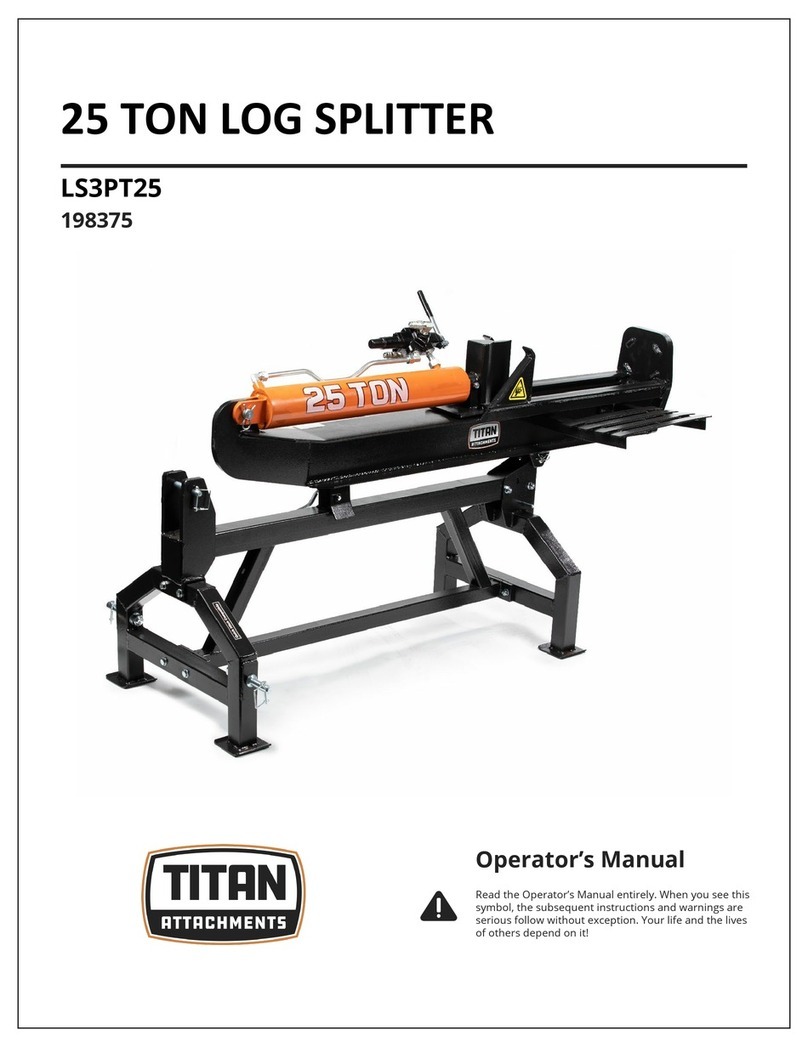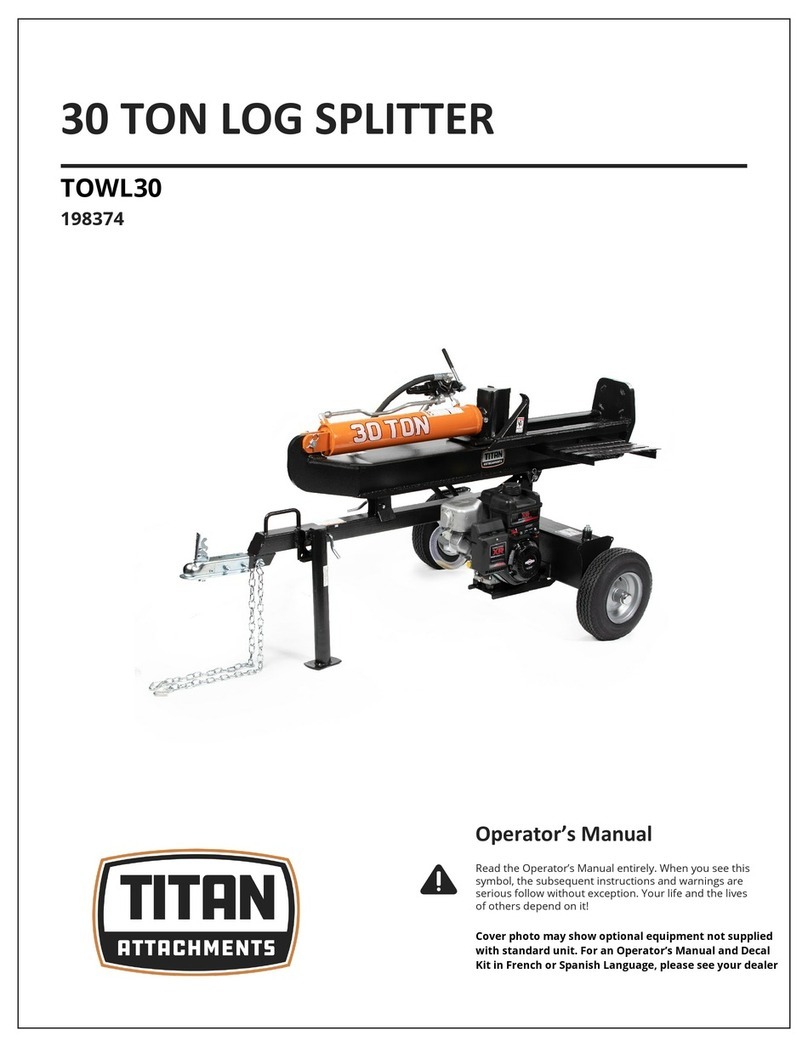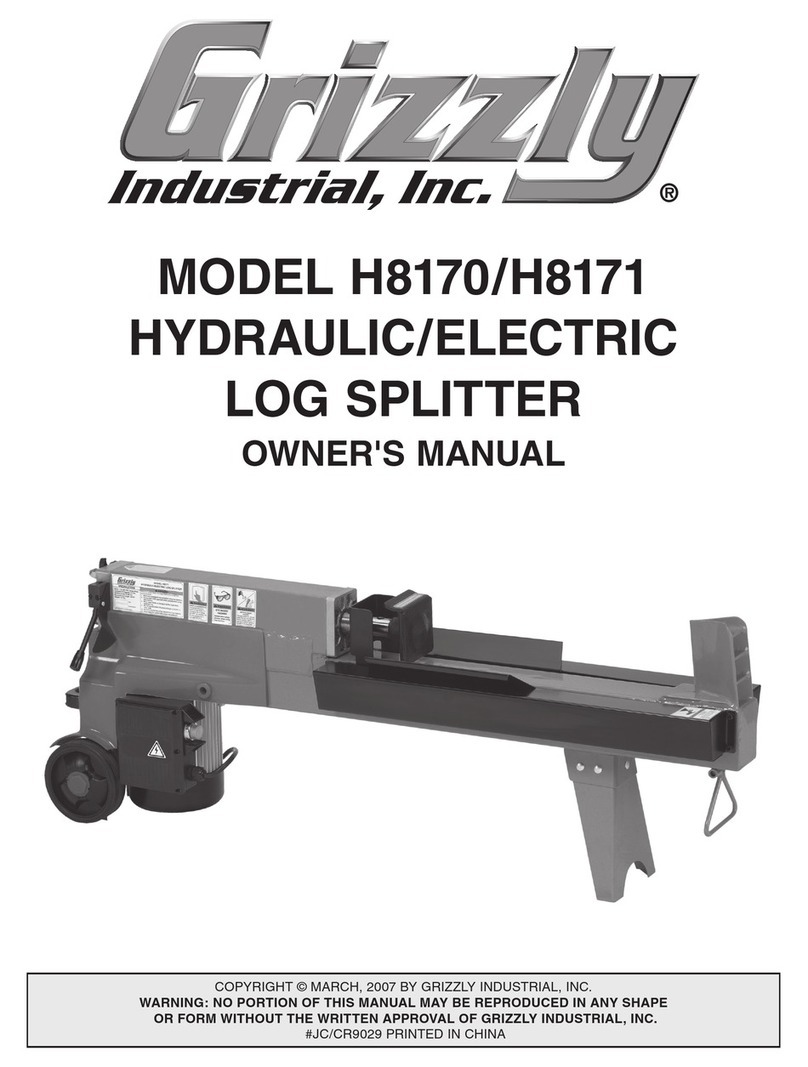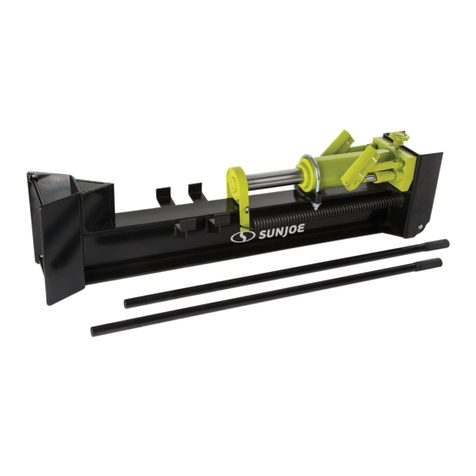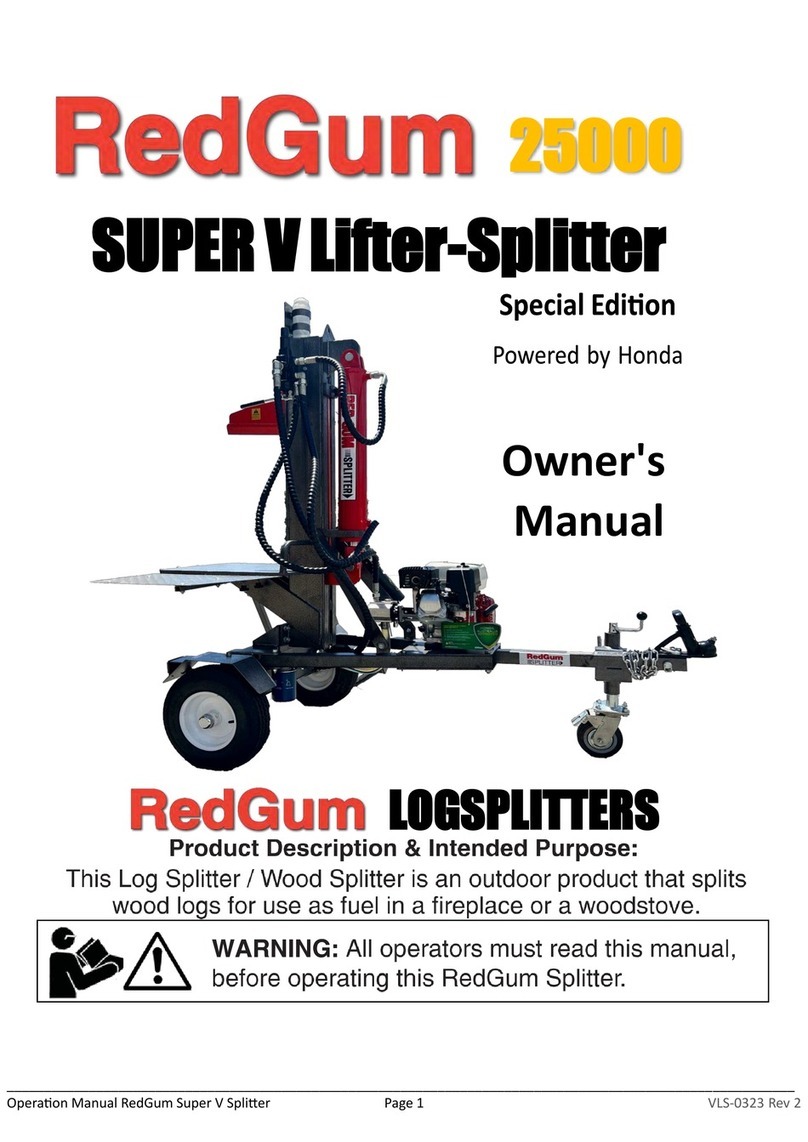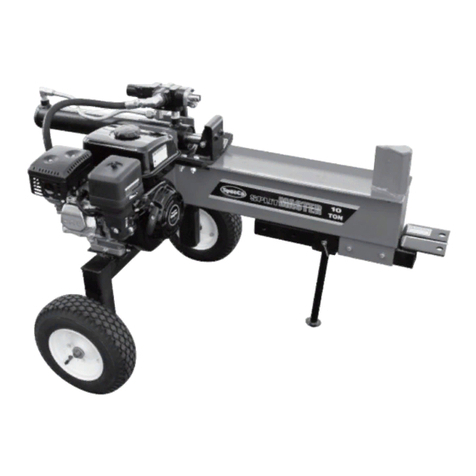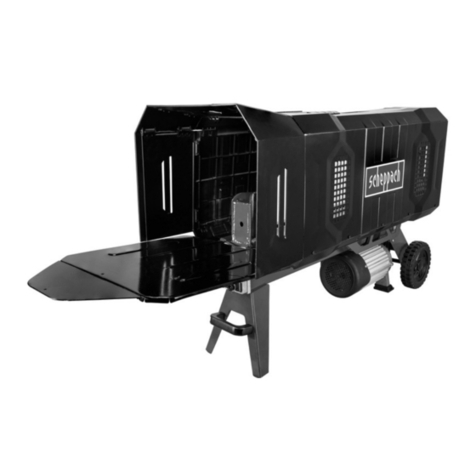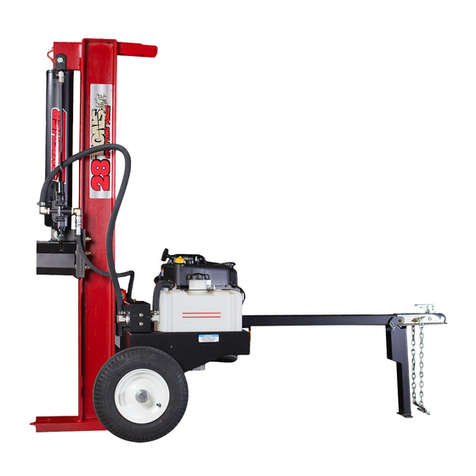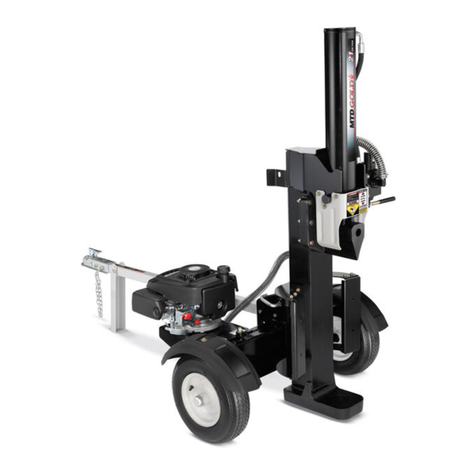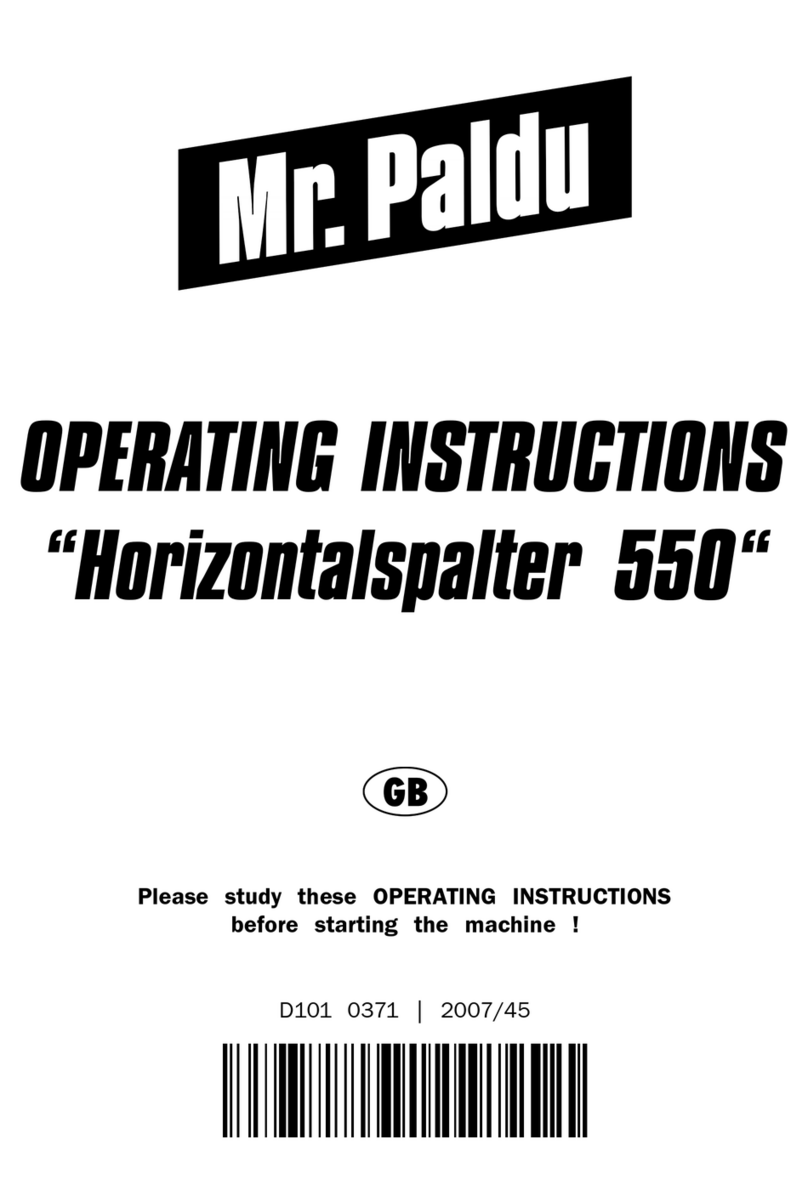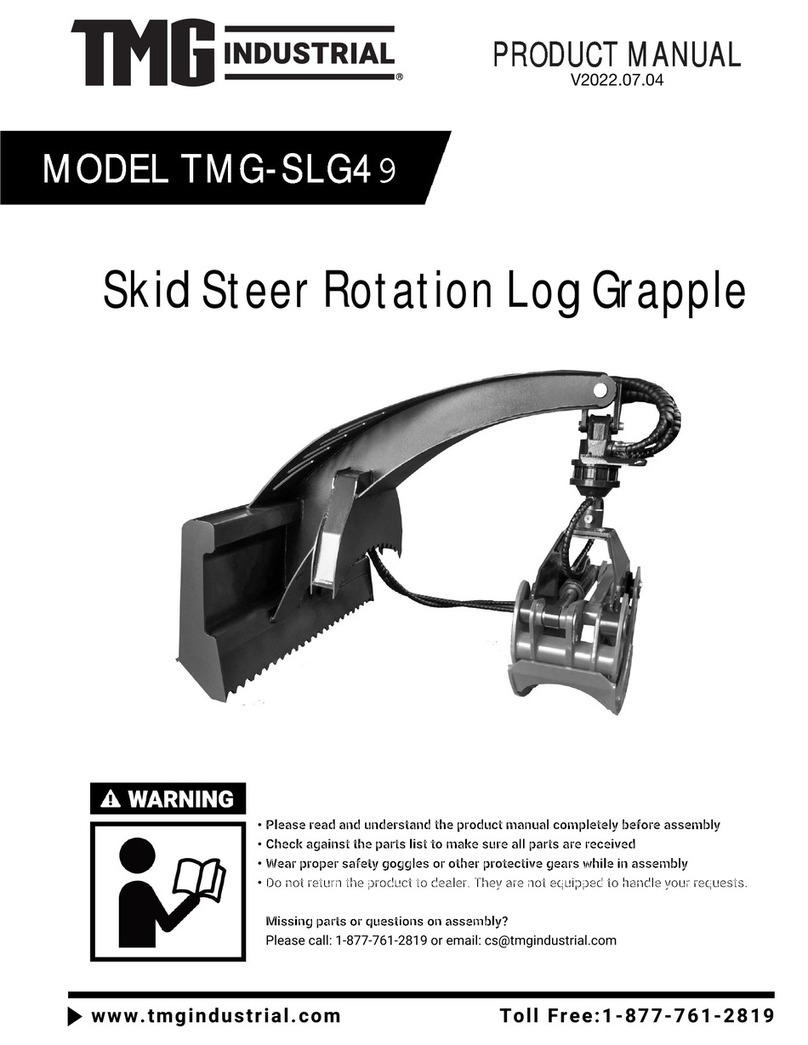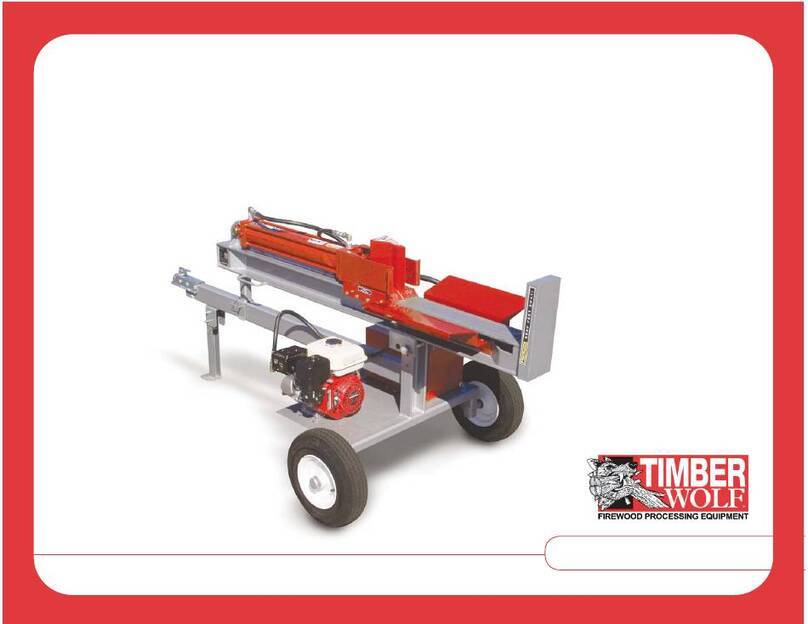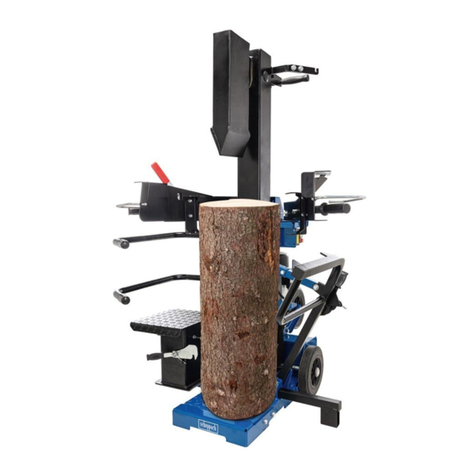Titan Attachments LSWX310 User manual

3PT HITCH LOG SPLITTER
LSWX310, LSWX350
198331,198335
Operator’s Manual
Read the Operator’s Manual entirely. When you see this
symbol, the subsequent instructions and warnings are
serious follow without exception. Your life and the lives
of others depend on it!

2
INTRODUCTION
The 20 Ton Vertical Hydraulic Log Splitter is an easy and efficient way to split lumber into
firewood with just a pull of a lever. With a standard Cat 1 3-point attachment system, it is a
breeze to transport and install. Integrating with your tractor's standard hydraulic system to
produce 20 tons of force making it perfect for the toughest jobs.
IMPORTANT SAFETY INFORMATION
THESE ARE STANDARD PRACTICES THAT MAY NOT APPLY TO THE PRODUCTS
DESCRIBED IN THIS MANUAL.
SAFETY AT ALL TIMES
Thoroughly read and understand the instructions given in this manual before operation. Refer
to the “Safety Label” section, read all instructions noted on them. Do not allow anyone to
operate this equipment who has not thoroughly read and comprehended this manual. Do not
allow anyone who has not adequately trained in the safe operation of the equipment.
•The operator should be familiar with all functions of the unit.
•Operate implement from the driver’s seat only.
•Make sure all guards and shields are in place and secured before operating the tool.
•Do not leave a tractor or implement unattended with the engine running.
•Dismounting from a moving tractor could cause severe injury or death.
•Do not allow anyone to stand between tractor and implement while backing up to
implement.
•Keep hands, feet, and clothing away from power-driven parts.
•Wear snug-fitting clothing to avoid entanglement with moving parts.
•Watch out for wires, trees, etc., when raising implements. Make sure all persons are clear
of the working area.
•Turning the tractor too tight may cause implement to ride upon wheels. This activity could
result in injury or equipment damage.
•Do not carry passengers on the tool at any time.
LOOK FOR THE SAFETY ALERT SYMBOL
The SAFETY ALERT SYMBOL indicates a potential hazard to personal safety, and individuals
must take safety precautions. When you see this symbol, be alert and carefully read the
message that follows it. In addition to the design and configuration of equipment, hazard
control and accident prevention depend on the awareness, concern, prudence, and proper
training of personnel involved in the operation, transport, maintenance, and storage.

3
BE AWARE OF SAFETY ALERT WORDS
DANGER: Indicates imminently hazardous practices. A situation that, if not avoided, will result
in death or severe injury. The signal word is limited to the most extreme situation, typically for
machine components that, for functional purposes, cannot be guarded.
WARNING: Indicates a potentially hazardous situation that, if not avoided, could result in death
or severe injury, and includes hazards that are exposed when guards remove. Use warnings to
alert against unsafe practices.
CAUTION: Indicates a potentially hazardous situation that may result in minor or moderate
injury if not avoided. It may also be used to alert against unsafe practices.
FOR YOUR PROTECTION
Thoroughly read and understand the “Safety Label” section, read all instructions noted on them.
SHUTDOWN AND STORAGE
•Lower machine to the ground, put the tractor in park, turn off the engine, and remove the
key.
•Detach and store implements in an area where children typically do not play
USE SAFETY LIGHTS AND DEVICES
•Slow-moving tractors, self-propelled equipment, and towed implements can create a
hazard when driven on public roads. They are challenging to see, especially at night.
•Flashing warning lights and we recommend turn signals whenever driving on the public
road.
TRANSPORT MACHINERY SAFELY
•Comply with state and local laws
•The maximum transport speed for implement is 20 mph, DO NOT EXCEED. Never travel at
a rate that does not allow adequate control of steering and stopping. Some rough terrain
requires a slower speed.
•Sudden braking can cause a towed load to swerve and upset. Reduce speed if the towed
load is not equipped with brakes.
Use the following maximum speed –tow load weight ratios as a guideline:
•20 mph when weight is less than or equal to the weight of the tractor.
•10 mph when weight is double the weight of the tractor.
IMPORTANT: Do not tow a load that is more than double the weight of the tractor.
KEEP RIDERS OFF MACHINERY
•Riders obstruct the operator’s view; they could be struck by foreign objects or thrown
from the machine.
•Never allow children to operate equipment.
•Practice Safe Maintenance

4
•Understand procedure before doing work. Use proper tools and equipment; refer to
Operator’s Manual for additional information.
•Work in a clean, dry area
•Lower the implement to the ground, put the tractor in park, turn off the engine, and
remove the key before maintenance.
•Allow implement to cool completely.
•Do not grease or oil implement while it is in operation.
•Inspect all parts. Make sure details are in good condition and installed correctly.
•Remove the buildup of grease, oil, or debris.
•Remove all tools and unused parts from implementation before operation.
PREPARE FOR EMERGENCIES
•Be prepared if a fire starts.
•Keep a first aid kit and fire extinguisher handy
•Keep emergency numbers for doctor, ambulance, hospital, and fire department near the
phone.
WEAR PROTECTIVE EQUIPMENT
•Wear protective clothing and equipment appropriate for the job. Avoid loose-fitting
clothing.
•Prolonged exposure to loud noise can cause hearing impairment or hearing loss. Wear
suitable hearing protection such as earmuffs or earplugs.
•Operating equipment safety requires the full attention of the operator. Avoid wearing
radio headphones while operating machinery.
AVOID HIGH-PRESSURE FLUIDS HAZARD
•Escaping fluid under pressure can penetrate the skin causing severe injury.
•Avoid the hazard by relieving pressure before disconnecting hydraulic lines or performing
work on the system.
•Ensure all hydraulic fluid connections are tight and all hydraulic hoses and lines are in
good condition before applying pressure to the system.
•Use a piece of paper or cardboard, NOT BODY PARTS, to check for suspected leaks.
•Wear protective gloves and safety glasses or goggles when working with hydraulic
systems.
•If an accident occurs, see a doctor immediately. Remember, any fluid injected into the skin
must be treated within a few hours, or gangrene may result.
TIRE SAFETY
•Tire changing can be dangerous, and trained personnel should be the only ones using
correct tools and equipment.
•When inflating tires, use a clip-on chuck and extension hose long enough to allow you to
stand to one side and NOT in front of or over the tire assembly. Use a safety cage if
available.
•When removing and installing wheels, use wheel handling equipment adequate for the
weight involved.

5
SAFETY SIGN LOCATIONS
The types of safety signs and locations on the equipment are shown in the illustration below. Good
safety requires that you familiarize yourself with the various safety signs, the type of warning and the
area, or particular function related to that area, that requires your SAFETY AWARENESS.
OPERATIONS
4.3 MACHINE BREAK-IN
Although there are no operational restrictions on the Wood Splitter when used for the first time, it is
recommended that the following mechanical items be checked:
1. After Operating For 5 Hours:
a. Check all nuts, bolts, and other fasteners. Tighten to their specified torque level.
b. Check hydraulic system for leaks. Tighten all leaking fittings and replace any leaking
components.
c. Check machine fluid levels: Fuel, engine oil, and hydraulic oil reservoir. Top up as required.
d. Check for entangled material. Remove all entangled material before resuming work.

6
4.4 PRE-OPERATION CHECKLIST
Before operating the machine and each time thereafter, the following areas should be checked off:
1. Use only with tractor under 100 horsepower.
2. Check that the machine is properly attached to the tractor. Be sure retainers are used on the
mounting pins.
3. Be sure extra weights are mounted on the front of the tractor if required.
4. Check the wedge and block. Be sure they are not damaged or broken and is not badly worn.
Repair or replace as required.
5. Check for entangled material. Remove this material.
6. Check for hydraulic leaks. Tighten fittings or replace components to stop leaks.
4.5 ASSEMBLY
1. Remove the package of control components from the frame.
2. Attach the lever to the control plunger and install the anchor pin and retainer.
3. Raise the lever into its vertical position and install the last anchor pin and retainer.
4. IMPORTANT: Be sure to spread the ends of the cotter pins retainers.
4.6 ATTACHING/UNHOOKING
1. When attaching the machine to a tow unit, follow this procedure:
2. Clear the area of bystanders, especially small children.
3. Make sure there is enough room and clearance to safely back up to the splitter
4. Place the tractor arms in their full sway position.
5. Back up slowly and align the lower link arms to the pins on the machine.
6. Connect the hydraulics:
a. use a clean rag or paper towel to clean the dirt from couplers on the hose ends
and the tractor.
b. Connect the hoses to the tractor couplers. Be sure the couplers are securely
seated.
c. Route and secure the hoses along the hitch with clips, tape, or plastic ties to
prevent binding and pinching.
d. Start the engine and place the tractor hydraulic lever in detent.
7. Move the splitter hydraulic lever to move the wedge.
8. Reverse the hoses if the wedge does not move in the same direction as the hydraulic
lever.
9. Slowly raise the machine through its operating range to make sure that there is no
interference or binding.
10. Level the machine front and rear, and side to side using the jackscrew on the right arm
and the turnbuckle on the top link.
11. To unhook from the tractor, reverse the above procedures. Always Park the machine in a
dry, lever area.

7
4.7 CONTROLS
The 3-position lever controls the flow of oil to the cylinder. Move the lever toward the base and
hold for the cylinder ram to extend and split the wood. Move the lever away from the base and
place in detent to retract the cylinder ram. Release the lever, it will return to its centered neutral
position when the pressure builds up enough to kick the lever out of detent at the end of the
stroke. The cylinder ram will stop moving.
4.8 FIELD OPERATION
When using, follow this procedure:
1. Review and follow the Pre-Operation Checklist (Section 4.4).
2. Starting:
a) Move tractor into its working position, lower the frame to the ground and set park
brake. Be sure the working area is level, dry and free of obstructions.
b) move the splitter wedge/cylinder to its fully retracted position.
c) position log between the wedge and the base of the frame.
d) move the hydraulic lever toward the base and hold it while the wedge moves
through the log.
e) release the lever when the log splits into 2 pieces or the wedge reaches the base
and the wedge will stop.
f) move the lever in the fully UP direction into detent. Release the lever and it will be
in detent until the ram reaches the end of the stroke.
3. Log placement:
a) Grasp the log by the sides when placing in the splitter to avoid splinters
b) Always wear the appropriate safety gear when working around the machine.
4. Operating:
a) Hold the hydraulic lever in the wedge extend direction until the wedge reaches the
base or the log/wood splits. Move it in the opposite direction to retract the
wedge.
b) Always keep the working area neat and clean to prevent tripping.
c) Do not place the splitter on muddy, icy, wet, or cluttered surfaces.
d) When machine is new lubricate the plate under the wedge slider each time the
machine is used to improve wear and reduce friction and/or binding. Once paint
is worn off it will polish itself.

8
SERVICE AND MAINTENANCE
5.1.1 FLUIDS AND LUBRICANTS
1. Grease: Use an SAE multi-purpose high temperature grease with extreme pressure (EP)
performance or SAE multipurpose lithium base grease.
5.1.2 GREASING
1. Use a hand-held grease gun for all greasing.
2. Wipe grease fitting with a clean cloth before greasing to avoid injecting dirt and grit.
3. Replace and repair broken fittings immediately.
4. If fittings will not take grease, remove and clean thoroughly. Also, clean lubricant
passage. Replace fitting if necessary.
SERVICING INTERVALS
1. The period recommended is based on normal operating conditions
2. Severe or unusual conditions may require more frequent servicing
3. Daily or 10 Hours
4. Lubricate wedge frame wear plates with graphite.
5. Do not use oil or grease as it collects dirt.
6. Annually Clean machine.
TROUBLESHOOTING
PROBLEM
CAUSE
SOLUTION
WEDGE DOES NOT MOVE
No pressurized oil
Place tractor circuit in dent to
provide oil
Wood jammed around wedge
Remove wood
WEDGE JUMPS
Wedge frame jamming
Lubricate wedge frame wear
plates
WEDGE MOVES IN THE WRONG
DIRECTION
Hydraulic hoses reversed
Reverse hoses

9
BOLT TORQUE
CHECKING BOLT TORQUE
ENGLISH TORQUE SPECIFICATIONS
Torque figures indicated above are valid for non-greased or non-oiled threads and heads
unless otherwise specified. Therefore, do not grease or oil bolts or cap screws unless
otherwise specified in this manual. When using locking elements, increase torque values by
5%.

10
WX310 PARTS DIAGRAM / EXPLODED VIEW

11
WX350 PARTS DIAGRAM / EXPLODED VIEW

12
ACKNOWLEDGEMENT OF RISK AND RELEASE OF LIABILITY
The use of any equipment, including this one, involves the potential risk of injury. Apart from any
warranty claim that might be presented for a claimed defect in material or workmanship of the product,
you accept and assume full responsibility for any and all injuries, damages (both economic and non-
economic), and losses of any type, which may occur, and you fully and forever release and discharge
Titan, its insurers, employees, officers, directors, associates, and agents from any and all claims,
demands, damages, rights of action, or causes of action, present or future, whether the same be known
or unknown, anticipated, or unanticipated, resulting from or arising out of the use of said equipment.
This equipment must be used with care by capable and competent individuals under supervision, if
necessary.
TITAN LIMITED WARRANTY: TERMS, EXCLUSIONS AND LIMITATIONS OF REMEDIES
This product comes with a one (1) year limited warranty that can be found at
www.palletforks.com/warranty.html. Please review the same for all details regarding the Titan Limited
Warranty.
THE TITAN LIMITED WARRANTY FOUND AT WWW.PALLETFORKS.COM/WARRANTY.HTML IS
EXCLUSIVE AND IS IN LIEU OF ALL OTHER WARRANTIES, EXPRESS OR IMPLIED, INCLUDING ANY
IMPLIED WARRANTY OF MERCHANTABILITY AND/OR FITNESS FOR A PARTICULAR PURPOSE, EACH
OF WHICH IS HEREBY DISCLAIMED.

13
NEED HELP? CONTACT US FIRST.
1-800-605-7595
www.palletforks.com
© 2021 Titan Brands
This manual suits for next models
2
Table of contents
Other Titan Attachments Log Splitter manuals
Popular Log Splitter manuals by other brands
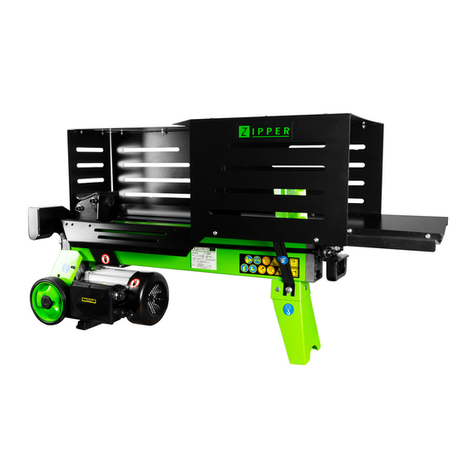
Zipper Mowers
Zipper Mowers ZI-HS5TN user manual

Craftsman
Craftsman 247.77466.1 Operator's manual
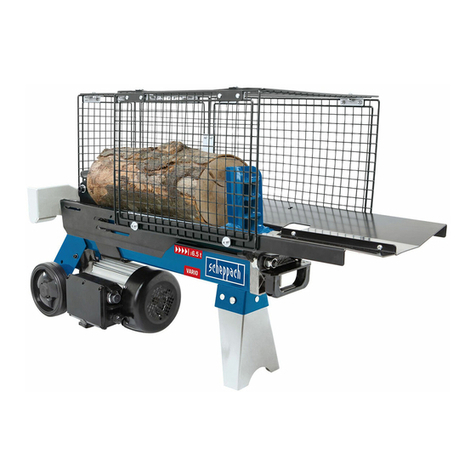
Scheppach
Scheppach HL660 Translation of the original instruction manual
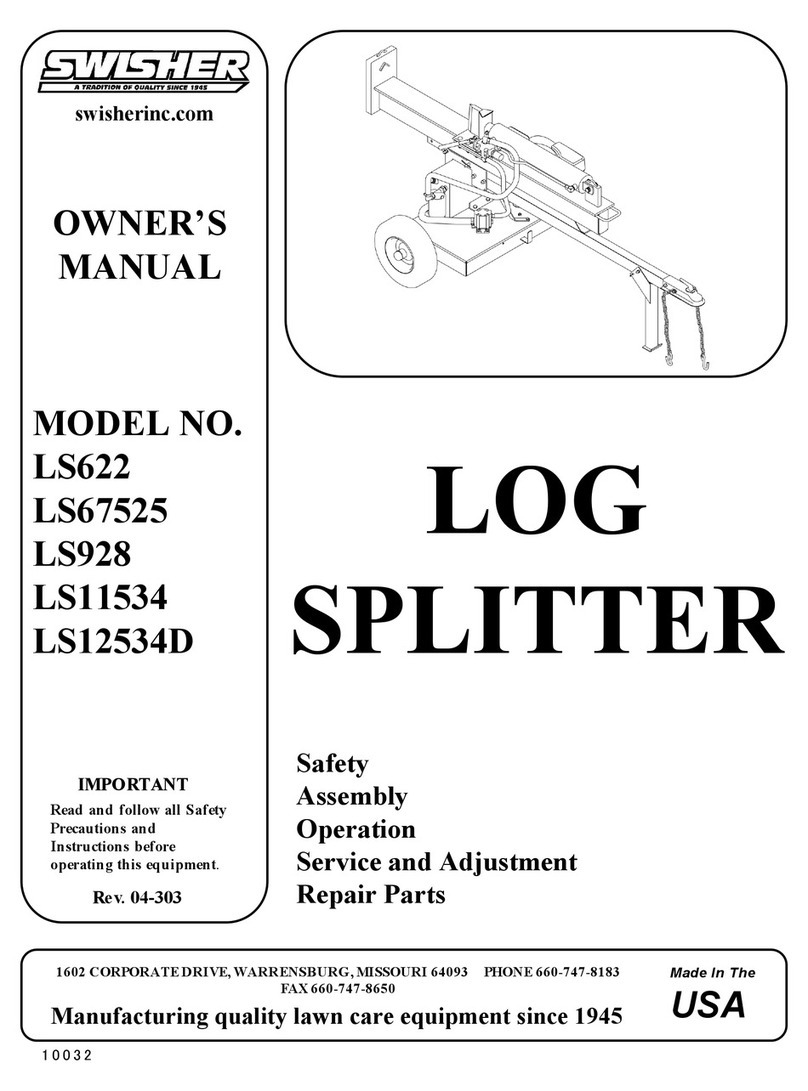
Swisher
Swisher LS11534 owner's manual

White Outdoor
White Outdoor 24AA570H190 Operator's manual
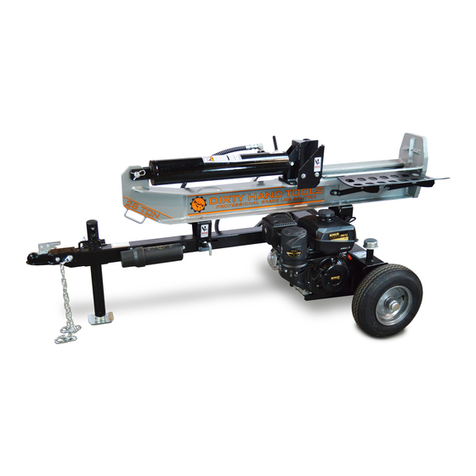
Dirty hand
Dirty hand 107036 Operation manual
